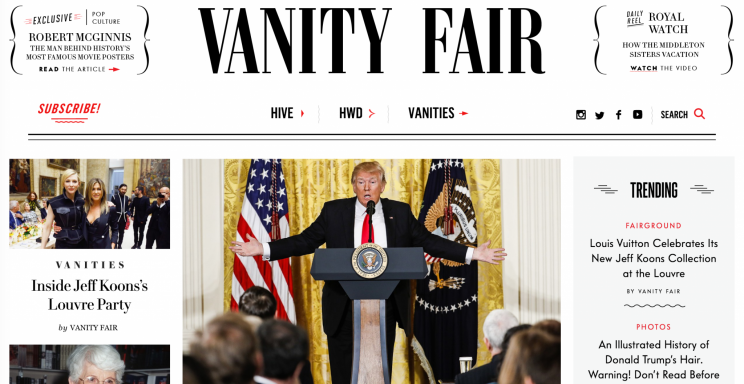Vanity Fair is planning a digital paywall

The magazine that President Trump called “dead” is trying something new. Vanity Fair is planning to roll out a digital paywall, Yahoo Finance has learned.
Vanity Fair editor-in-chief Graydon Carter wants the new paywall ready in the next two to six months, according to communication seen by Yahoo Finance. Years ago, the magazine very rarely made select print features subscriber-only (like a 2014 cover investigation on Edward Snowden) but it did not have any formal, metered paywall.
The new move comes after the Conde Nast title saw its web traffic and digital revenue go up recently. Adweek reported that VF.com’s 14 million monthly unique visitors last October was up 27% over a year before. And its digital revenue was up 74% year over year.
Perhaps that’s why Carter believes now is the time for a paywall. So, will online readers pay up? (Conde Nast did not provide a comment for this story.)
Has anyone looked at the really poor numbers of @VanityFair Magazine. Way down, big trouble, dead! Graydon Carter, no talent, will be out!
— Donald J. Trump (@realDonaldTrump) December 15, 2016
In December, after the magazine published a scathing restaurant review of Trump Grill in Manhattan’s Trump Tower, Trump tweeted that Vanity Fair was “way down” and in “big trouble.” But that day, Vanity Fair sold 100 times more new subscriptions than it usually sells in a day, and quickly gained 10,000 new Twitter followers.
Vanity Fair is now using the tagline, “The magazine Trump doesn’t want you to read” in its subscription advertisements. On Wednesday, the web site published “The optimist’s guide to impeaching Donald Trump.”

Many print newspapers have experimented with paywalls online, with varying levels of success and varying degrees of “porousness.” (Some of them can be evaded simply by turning off your ad-blocker or switching your browser to incognito mode.) The New York Times, Wall Street Journal (NewsCorp-owned), Washington Post, Chicago Tribune (Tronc), and Boston Globe, to name a few, all have a “metered” approach, meaning they allow you a certain number (typically 10-20) of free articles per month before you must log in and pay. Business Insider has also been testing out a partial paywall. The Financial Times switched its metered model to a “hard” paywall in 2015.
In England, the Daily Telegraph and Sunday Telegraph recently introduced a paywall with a twist: only the “most unique, in-depth and insightful journalism” is behind the wall, which amounts to 15% of its articles.
As of one year ago, according to a report at the time from the American Press Institute, 79% of US newspapers with circulation over 50,000 had implemented some sort of paywall. The average weekly price of subscription: $3.11.
In magazines, The Nation launched a metered paywall last year, while Newsweek went the other way, dropping its paywall. At Time Inc, different magazine brands have taken different strategies: Time.com still has a paywall in place for many of its archived stories, while Fortune.com, which briefly tested a paywall for some print features a few years ago, quietly stopped.
The New Yorker is often cited as a paywall success story. It implemented a metered paywall in 2014, and by October 2015 its monthly unique visitors had nearly doubled from the year before, the Wall Street Journal reported.
One can expect Vanity Fair to go with a similar setup to The New Yorker, as both are Conde Nast publications. Vanity Fair has had recent success with its tech blog, The Hive—that’s likely a section that wouldn’t go behind the wall.
Back in 2010, Conde Nast’s then-VP of business development said at a conference, “Walling off our content and saying ‘you can’t have it,’ I don’t think that’s the right strategy.” But that was seven years ago, and that executive is no longer at Conde Nast.
In his now-famous tweet about Vanity Fair, Trump added that Graydon Carter is “no talent” and “will be out!” But if the VF.com paywall works well, media industry pundits may end up declaring the opposite.
—
Daniel Roberts is a writer at Yahoo Finance, covering sports, tech, and the media business. Follow him on Twitter at @readDanwrite.
Read more:
Inside the ugly breakup of Sports Illustrated, The Cauldron, and Chat Sports
Time Inc enacts plan to boost bonuses of top execs in case of sale
Who wants a piece of Time Inc?
The Yahoo media brand is not changing its name to Oath

 Yahoo Finance
Yahoo Finance 